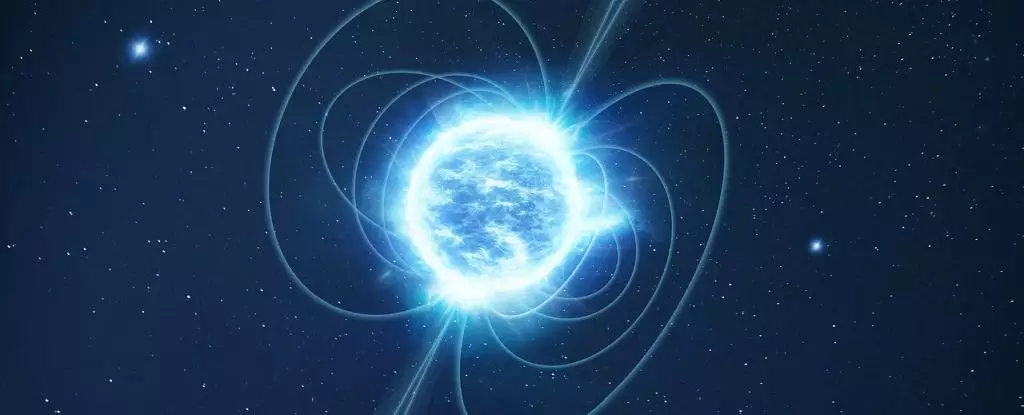Deep in the cosmic expanse of the Milky Way resides a heavenly body that continues to defy our understanding—SGR 0501+4516. This magnetar, one of the universe’s more tantalizing entities, has presented astronomers with an array of intricate questions regarding its origin and nature. Employing cutting-edge technology from the Hubble and Gaia telescopes, scientists have made intriguing discoveries that challenge our foundational theories about magnetar formation. In light of these revelations, we are prompted to reconsider the very mechanisms by which these extraordinary stars come into existence.
The Intriguing Nature of Magnetars
Magnetars are an extraordinary subset of neutron stars, remarkable for possessing an unparalleled magnetic field intensity—about a thousand times greater than a typical neutron star and a staggering quadrillion times stronger than that of Earth. Neutron stars themselves are extraordinary objects, formed when massive stars exhaust their nuclear fuel, collapsing under gravitational forces in a spectacular core-collapse supernova. Historically, it was believed that magnetars followed a similar pathway, birthed from such cataclysmic events. However, SGR 0501+4516 has thrown a wrench into this conventional wisdom, prompting a deeper inquiry into the stellar lifecycle.
The diversity of stars across the universe reveals the fascinating processes of stellar evolution, yet the precise paths leading to the formation of magnetars have remained elusive. If we assume that SGR 0501+4516 formed similarly to its neutron star relatives, the evidence gathered from its surroundings seems counterintuitive. Positioned conveniently near the supernova remnant HB9, SGR 0501+4516 seemed to support the conventional hypothesis linking it to a supernova event. Yet one key detail—a lack of movement correlating with HB9—has sparked significant reassessment of its lineage.
Challenges to Established Theories
Utilizing the high-resolution capabilities of Hubble alongside Gaia’s precise astrometric measurements, astronomers, led by Ashley Chrimes from the European Space Agency, dissected the movement patterns of SGR 0501+4516. Their analysis uncovered that the proper motion and velocity of the magnetar indicate a clear disassociation from the nearby HB9 remnant. This critical finding lays waste to the assumption that the two objects share a common origin.
Astrophysical logic suggests two primary possibilities in light of this revelation. One scenario posits that SGR 0501+4516, originally classified as being around 20,000 years old, may actually have an older age, quenched yet intact in the fabric of space-time. If this were true, one would expect any associated supernova remnant to have long since dissipated, leaving only SGR 0501+4516’s electromagnetic wonders in its wake.
The more thrilling alternative suggests a completely novel formation mechanism. If SGR 0501+4516 didn’t emerge from a standard core-collapse supernova, its genesis could stem from a merger event. This could involve collisions of two low-mass neutron stars or unique interactions with a white dwarf—a stellar remnant known for its binary companions, from which it can siphon mass. The intricate dance of these bodies could potentially lead to unforeseen stellar transformations, depicting the chaotic beauty of cosmic interactions.
Revolutionary Insights into Stellar Evolution
Renowned astronomer Andrew Levan highlights a fascinating theory regarding the transformation of white dwarfs into neutron stars through unconventional pathways. Specifically, under rare but possible conditions, a white dwarf that accumulates excessive mass may avoid classical thermonuclear detonation and instead transition into a neutron star. If SGR 0501+4516 indeed originated from such an event, it would represent a groundbreaking shift in our understanding of stellar evolution.
The implications of this evolving narrative are profound. For a long time, we have tethered our understanding of magnetars to the emotionally charged dramatic finale of a supernova. Now, as we confront the possibility of SGR 0501+4516 being a product of a subtle yet violent cosmic rendezvous, we are invited to grasp the nuanced complexity of the universe’s stellar children—reminding us that in the vast cosmic theatre, there remain mysteries untold and mind-bending possibilities waiting to be unraveled.
Shifting the Paradigm of Cosmic Understanding
The case of SGR 0501+4516 stands as a testament to the fact that science is an ever-evolving field. As we forge ahead in unraveling the complexities of magnetars, we are challenged not only to refine our theories but to embrace the unknown. With only about thirty known magnetars residing in our Milky Way, SGR 0501+4516 emerges as a crucial object of study, urging us to explore uncharted territories when it comes to stellar life cycles.
In a universe characterized by constant change and turmoil, SGR 0501+4516 serves as a reminder that even our most cherished hypotheses can be shaken to their very core. Each new discovery invites us to dive deeper, encouraging a scientific mindset that is both inquisitive and adventurous, reinforcing the notion that in the dance of cosmic phenomena, the most breathtaking revelations are often born from uncertainty.


Leave a Reply